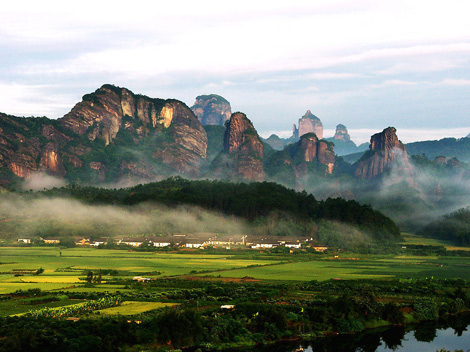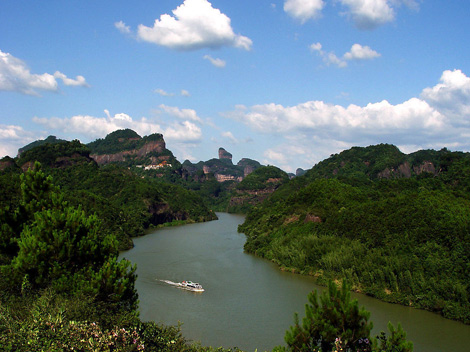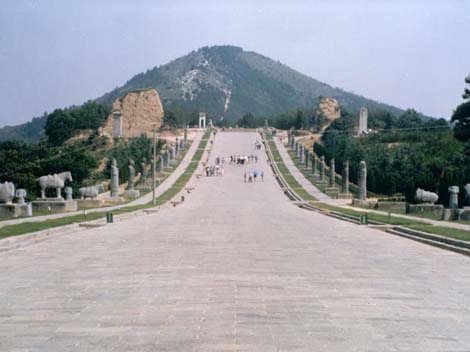| Home > China Feature |
Danxia Mountain in Guangdong
Danxia Mountain is a world famous geopark, containing the largest, most beautiful scenic area in Guangdong. The mountain is situated in Renhua County, about 45 kilometers (28 miles) from Shaoguan City, Guangdong Province. The Danxia Landform of this mountain represents the typical formation of the over 1,200 Danxia Landforms found throughout the world. Covering an area of more than 280 square kilometers (69,190 acres), the mountain is composed primarily of red sandstone rocks.

The scenic area contains more than 680 various stone peaks, stone fortresses, walls, pillars and stone bridges. The stones have been formed over the eons by nature, many of which take the shape of the human body, birds and even animals. The numerous stones and peaks are rhythmically interspersed among the scenic spot, making it a sculpture garden of red sandstone rocks. Set against the blue sky, white clouds, jade waters, green trees and the colorful algae, the mountain becomes a picturesque painting.

The enchanting mountain has a rich variety of plants due to the moderate subtropical climate and the yearly monsoons that provide plenty of rainfall. There are twenty-eight ancient trees over one hundred years old, with fourteen of them having survived for more than three centuries. These ancient Danxia Phoenix Trees are native to this area and are the most distinguished species of the mountain. Of the ten varieties, four of them are extremely rare. One such variety of the Phoenix Trees has been named the 'Dharma Orchid'. It was discovered in 1987, and only two of them have existed in the world. When flowering season arrives, the sweet scent of the orchid tree lingers in the mountain and visitors swarm to its attraction.
The Danxia Mountain consists of many other wonderful scenic spots, including Zhanglao Peak, Yangyuan Hill, Xianglong Lake and Jin River. At the foot of Zhanglao Peak, there is a grotto temple that was built during the Northern Song Dynasty (960-1127). The Biezhuan Temple, which lies in the middle of the Zhanglao Peak, is one of the ten most notable temples of Guangdong. Yangyuan Hill and Zhanglao Peak face each other across a river. The hill is renowned for the marvelous Yangyuan Stone, which looks like a male genital. The Xianglong Lake (Flying Dragon Lake) sits to the south of Zhanglao Peak, named so because the lake resembles a flying dragon. The Jin River features charming waterside scenery and wonderful aquatic programs, such as swimming, boating and yachting.

Countless cliff tombs and cliff coffins of times long ago were left by our ancestors who inhabited the mountain. In addition, the mountain has been a busy place for Buddhism activities since the Sui (581-618) and Tang Dynasties (618-907). In the Ming and Qing Dynasties, the mountain prospered and more than eighty temples were built. A great number of poems, carvings and inscriptions praising the bewitching scenery were left behind by writers, poets and painters throughout past dynasties.
Art
 more
moreSculpture in Qianling Mausoleum
The sculpture of Qianling Mausoleum is the main relic of the ground ...

A Sweet Art:Sugar Painting
In and around China’s southwestern Sichuan Province, it is usual to ...

Chinese Treasure Displayed at Sha...
There are four treasures of the Chu Minority Culture displayed at th...

Custom
 more
more




 print
print  email
email  Favorite
Favorite  Transtlate
Transtlate 







